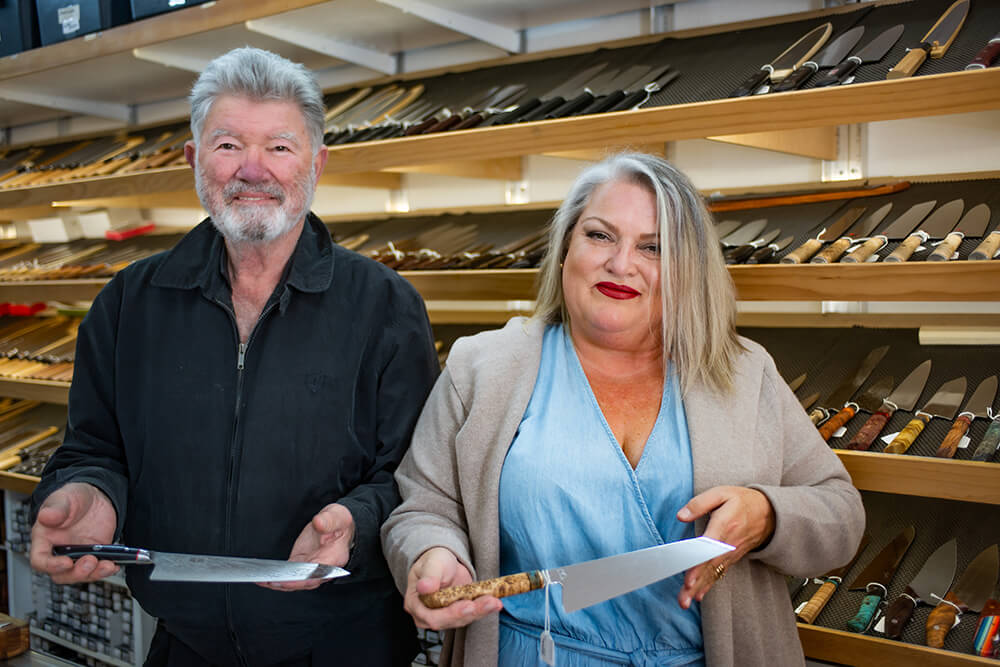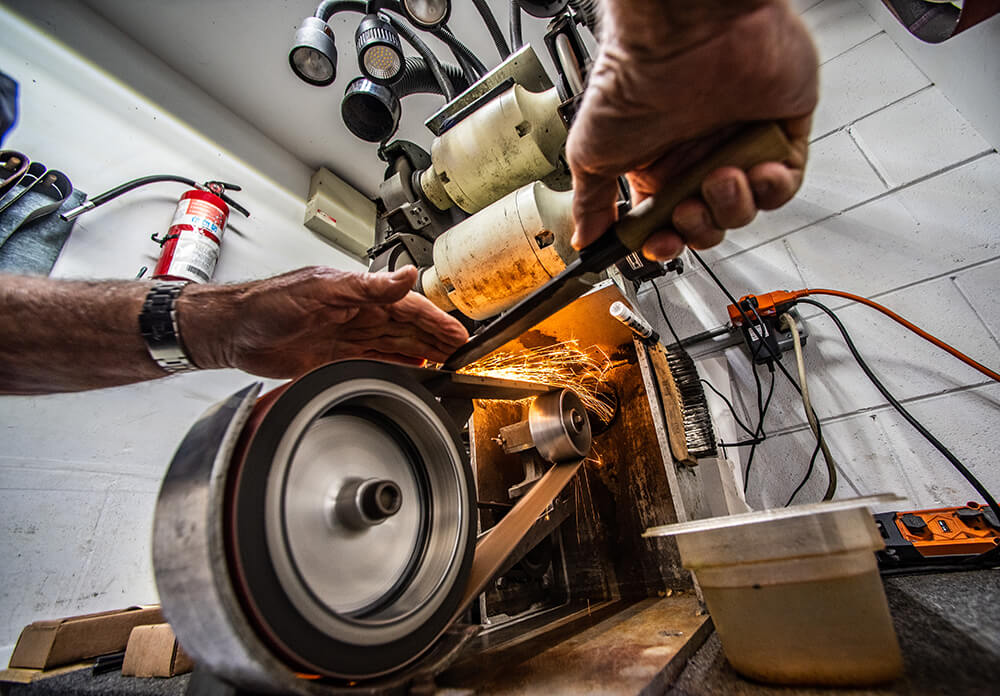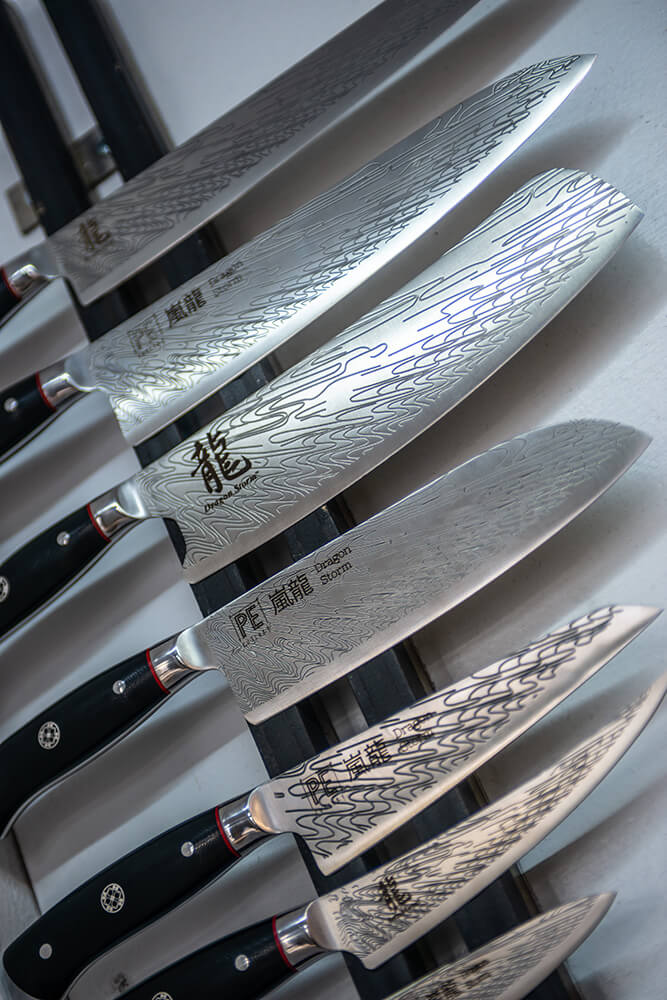Words by Johanna Harlow
It’s a gallery dedicated to the art of steel. Enter Perfect Edge Cutlery in San Mateo—a knife and sharpening shop—and behold Baldwin Blades with birch, maple and walnut handles. Meglio metal etched with swirling Mayan symbols and coiling sirens. Damascus steel with layers rippled like tree rings. Here, even the less flashy knives assume masterful shape and form. Unwielded, these functional beauties await the call to action on the cutting board.
“Our job is to know everything about every one of these knives,” says Tara Ransfer, a self-proclaimed knife nerd who runs the business with her father, Mike Solaegui. From Messermeister to Miyabi, Kai to Kikuichi, Tara knows them all.
Mike’s interest lies in the sharpening side of the business, in returning blades to their intended purpose of slicing and dicing at a rapid staccato beat. He offers this service at the shop—evident in the whir of the sharpening blade in the back room—but also takes out their mobile truck, making rounds to restaurants ranging from mom-and-pop to Michelin-starred. They’ve serviced Google’s numerous campus cafes, the Michelin-darling French Laundry in Yountville, Madera in Menlo Park, and many a Marriott and Hyatt hotel kitchen, among countless others.

And with the motto, “If it has an edge, we can do it,” they hone more than knives, caring for the blades of immersion blenders, kitchen shears and food processors. “They need somebody they trust to do a good job. That’s us,” Mike states. Tara nods her agreement, “Knife sharpening is a skill the same way learning to cook is a skill.” By both sharpening and selling knives, the duo has gained a deeper understanding of this kitchen essential. “Neither one tells the full story,” continues Tara. “If the heat treatment is off with one of the knives, sharpening will tell you which one.”
Mike, once a butcher like his father, understands the value of an effective tool. “My grandfather was the first person who set me up with a tri-stone sharpener to just mess around with,” Tara recollects of her after-school visits to the meat shop.
Now celebrating Perfect Edge’s 30th anniversary, father and daughter continue to steer customers to the right knife through a series of questions. After all, the two-inch paring knife, while great for peeling apples, isn’t up to fileting hefty tuna like the three-foot maguro bōchō blade. “We want to know what you’re going to cut on,” Tara notes, “what you’re going to use the knives on, how much maintenance you’re going to want to do, how much experience you have in using knives.”

Your answers might very well determine where your knife originates. Always on the cutting edge, Mike and Tara’s business became one of the first to sell game-changing Japanese cutlery in the Bay Area. This was back in ‘98, when German knives reigned. “I think it’s fair to say that the Japanese knives were coming in sharper than the German and American-made knives,” Mike says. “It’s harder and more flexible, so you can make it thinner.” Later, celebrity chef Rachael Ray popularized Japanese knives by brandishing her favorite santoku on 30 Minute Meals. “Every time she would talk about it on her show, we would sell 24 or more that week—easily,” Tara recalls.
That doesn’t mean everyone should get one. If you’re used to manhandling your blades, you’d be best served with something more durable. Tara holds up a supple santoku. “You get that in a bone—even on the woody stem of a piece of rosemary—hit that just wrong, and you can chip that edge.” She indicates a German chef’s knife. “This is a little more forgiving in the average person’s hands.” American manufacturers are also stepping up their game of late. “One is not better than the other,” Tara stresses, adding, “Picking the right one for its purpose is ultimately going to give you the best result.”

They also need to know if you’re looking for a reliable workhorse or the luxury experience. “You’ll hear a lot of analogies with cars when knife people talk,” Tara chuckles. Mike points out a Dragon Storm santoku: “Toyota Camry.” Then indicates the wider blade of a Running Man Forge bunka: “Porsche.” “If you want to go four-wheeling, you’re not going to select a Ferrari to do that,” Tara reasons.
With authority forged from decades in the field, the duo also brings their own knives to the table. Like their Dragon series, a line tailored for home cooks and professional chefs alike that blends Japanese and European knife-making traditions. “We design it, we spec it, we pick all the materials, we do the prototype,” Mike explains. “Then we approve the manufacturer’s preliminary production, make corrections, approve it.”
They’ve also carefully considered cost, ensuring their designs are not only aesthetically pleasing, but also affordable for professional chefs. Tara cocks her head at a gyuto chef’s knife with a resplendent redwood handle. “They won’t be beating that up in a 12-hour shift on the line, you know?” That’s why she and Mike tasked themselves with finding an answer to the question: “How much of a knife can we give them for under $200?”

And the pros came. Tara recalls the time the head chef at the Ritz Carlton called at 10:30 in the evening to ask if he could bring over his pal, celebrity chef Anthony Bourdain, for some late-night shopping. “So yes, I had intoxicated chefs in the store after hours,” she laughs.
Back in the day-to-day bustle of the shop, the afternoon sunlight hits the room—and everything glows. Mike and Tara look content among the bristling shelves. “I can have hours-long conversations about nothing but knives,” Tara declares.
Fun Fact: “Almost all culinary knives descend from weaponry,” notes Tara. Take Japan’s Kikuichi Cutlery, which originated from a 13th-century swordsmith, supplying Nara’s warrior monks with samurai blades. Think about that the next time you’re doing battle with an obstinate pineapple.


